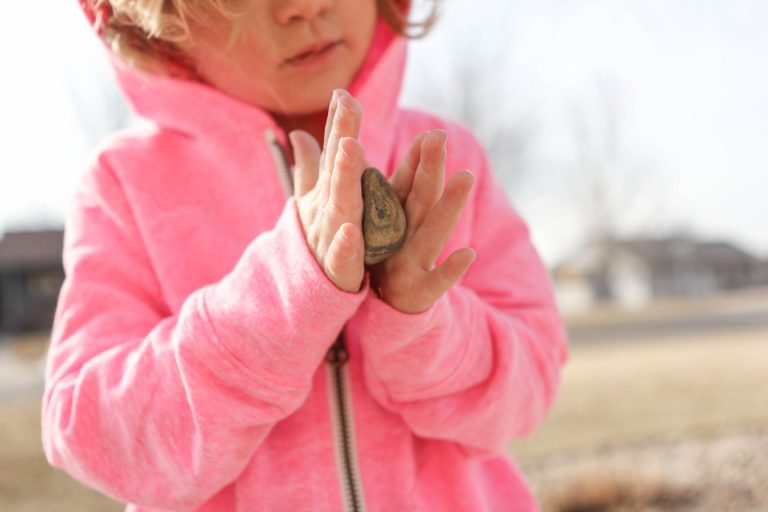New grade. New teacher. New drop-off line. Whether it’s starting Kindergarten or heading into a new school year, transitions can be a rollercoaster for young kids—and let’s be honest, for parents too. Oftentimes, we see this manifest as weird coping mechanisms in kids.
If your child is suddenly clinging to an old sock or talking to themselves like they’re the star of a one-kid play, you might be wondering: Is this normal? The short answer? Yes. Totally. These weird coping mechanisms in young children are not only common — they’re developmentally expected.
Here’s a closer look at the quirky, surprising ways kids handle big change — and why most of it is nothing to worry about.
1. The Transitional Object: Sacred Stuffy, the Random Rock
- You might notice your child gripping a random object on the way to school — a tiny stuffy, a beat-up rock from the backyard, or even a neon Band-Aid stuck to nothing at all. These “transitional objects” may seem odd, but they actually play a powerful psychological role in helping kids feel safe.
Here’s the science-y bit: Transitional objects are stand-ins for comfort and connection, often tied to a caregiver or home environment. The term was coined in the 1950s to describe items that help young children shift from total dependence to greater independence. These objects act as emotional security blankets — literal or figurative — when kids are navigating unfamiliar territory.
It’s less about the object itself, and more about what it represents: Home, predictability, and you- comfort!
So go ahead and let them bring the lucky rubber duck. It’s doing more heavy lifting than you think.
2. Full-Blown Monologues and Invisible Friends: Why Private Speech is Normal in Times of Transition
If your kiddo is suddenly narrating their life like a tiny podcast host, don’t worry — they’re not losing it, they’re self-soothing.
This running dialogue is called private speech, and it’s actually a sign of growing cognitive development. Kids don’t talk to themselves because they’re confused, but because they’re organizing thoughts, solving problems, and mentally rehearsing new experiences.
For example:
-
“First I put my lunchbox here… then I sit on the carpet…”
-
“Don’t forget to raise your hand, don’t forget, don’t forget…”
Private speech helps them process routines, calm anxieties, and build independence. It’s often more noticeable during transitions, when kids are learning new patterns and expectations. (It’s also kind of adorable.)
So when you hear your child whispering to themselves at drop-off, think of it like their personal pep talk — not something to correct ❤
3. Rituals That Ground Kids in Times of Transition
You might notice your child becoming strangely insistent on certain routines: only eating with the red spoon, needing to zip their backpack exactly halfway, or always being the third one in line.
These rituals are usually harmless and helpful. When life feels unpredictable, small routines provide a sense of control. They’re like mental handrails, helping kids feel steadier in unfamiliar settings.
This need for sameness often spikes during big changes, and while it can test your patience, it usually fades as they settle in. Unless it’s interfering with daily functioning, it’s best to roll with it.
4. Regression: When Kids Go Backward to Move Forward
One of the most common — and often most confusing — responses to change is regression. This is especially true in younger children, who are still building the emotional tools to handle new routines, settings, and social expectations.
Regression is when a child temporarily returns to earlier behaviors they had already outgrown — like baby talk, accidents, needing help with tasks they’ve previously mastered, or suddenly wanting a bottle or pacifier again. It can feel like a step backward, especially when you’re already navigating the chaos of a big transition like starting Kindergarten. But in reality? It’s a normal and expected part of development.
It can be surprising, especially if your child has been “ahead” developmentally. But regression is often a sign of stress, not a sign that something is wrong. It’s their way of saying, “This is hard. I need to feel safe right now.” Don’t punish it or panic. Offer gentle support, keep your routines consistent, and they’ll usually bounce back on their own.
So what do you do if your child asks for a bottle again?
You don’t have to cave — but you also don’t have to shut it down harshly. The bottle isn’t really about thirst or hunger — it’s about comfort. Instead of saying no outright, try meeting the emotional need in a more age-appropriate way. You might say:
“That bottle helped you feel safe when you were younger, but let’s find something esle to help you feel cozy now.”
Then offer alternatives like: a warm drink in a “big kid” cup, some extra snuggle time, a cozy spot with a favorite blanket and story, a special stuffed toy, or a sensory toy.
It’s not about denying comfort — it’s about helping them find new ways to feel secure as they grow.
5. Meltdowns Over Muffins: The Classic Stress Release
New transitions often bring new tantrums — and they’re rarely about what they seem to be about.
If your child bursts into tears over having the “wrong” cereal or flips out about mismatched socks, chances are they’re emotionally maxed out. School takes a ton of energy — mentally, socially, and emotionally — and once they’re home, the lid pops off. This kind of behavior is known as after-school restraint collapse, and it’s common in early elementary years.
To help:
-
Build in quiet time after school
-
Avoid peppering them with questions right away
-
Offer snacks and low-demand environments
You’ll be amazed what a granola bar and some couch time can fix.
6. Obsessing Over One Tiny Thing? That’s Hyperfocus
Is your child very interested in one part of their new classroom? Like, only wants to talk about the clock, or how the snack table is shaped like a triangle? That’s hyperfocus — and it’s more common than you might think.
While it’s often associated with neurodivergent kids (especially ADHD or autism), this type of narrow focus can show up in any child during big transitions. Why?
Because focusing on one small, specific detail makes the overwhelming whole feel more manageable. Think of hyperfocus as their brain’s way of tuning out the chaos by zooming in on something small and predictable. It’s a bit like finding a little safe island in a sea of new rules, noises, and faces. This narrow focus helps kids:
-
Break down a big, confusing environment into manageable pieces
-
Feel a sense of control and mastery over something they can understand
-
Calm anxiety by giving their attention a clear target
It’s important to remember that hyperfocus isn’t just about intense interest — it’s often a coping tool, a way to self-soothe and regulate emotions when faced with big changes. So instead of trying to pull them away too quickly, observe if this focus is helping them settle in. If it’s interfering with social interactions or flexibility, gently encourage new experiences — but if it’s their comfort zone for now, it’s okay to let them hang out there a little longer.
7. Becoming the Teacher’s Little Helper: When Helpfulness Is a Coping Strategy
Suddenly your child is volunteering to stack chairs or wipe tables? This might be their way of easing anxiety and finding purpose. If your usually quiet or shy kid suddenly wants to volunteer to wipe tables, hand out papers, or organize toys, it might be their way of managing all the new feelings swirling around a big transition.
Being helpful gives kids a sense of purpose and control in a situation that might otherwise feel unpredictable. When everything is changing — new faces, new rules, new schedules — stepping up to help can:
-
Build their confidence and self-esteem
-
Give them positive attention from adults
-
Create a feeling of belonging and usefulness
-
Distract from anxiety or uncertainty
For many kids, especially those who are naturally eager to please or sensitive to social cues, helpfulness is a way to connect without having to dive into tricky social conversations or complicated feelings right away.
That said, it’s good to watch that this helpfulness doesn’t turn into a pressure to “fix” everything or a way to avoid dealing with emotions. Encourage their enthusiasm, but also check in with gentle questions like, “How are you feeling?” or “Do you need a break?” to make sure they’re not overextending themselves emotionally.
8. When Kids Go Quiet: Withdrawal vs. Worrying Signs During Times of Transition
Some children handle transitions by going quiet — not in distress, but in self-preservation.
Normal withdrawal can look like:
-
Solo play during recess
-
Observing more than participating
-
Short, quiet answers
This is often just a processing pause. Some kids need time to warm up to new routines and social groups.
But when should you worry?
🚩 Red flags to watch for:
-
Silence across settings (home, school, familiar spaces)
-
Persistent sadness or irritability
-
Refusing to go to school, eat, or sleep
If quiet behavior lasts more than 3–4 weeks without improvement, or you see other signs of distress, check in with your child’s teacher or pediatrician.
When Are These Weird Behaviors Just a Phase, and When Should You Step In?
Most weird coping mechanisms in young children are just that — coping. They’re temporary, developmentally normal responses to a brand-new situation. With time, consistency, and lots of reassurance, kids usually adjust within 3 to 6 weeks of a major transition. So, if they’re just starting school, do a mental check-in after 6 weeks or so and see whether they’re settling into the new routine.
Here’s when to keep watching:
-
The behavior is escalating rather than easing
-
It’s interfering with learning, friendships, or daily life
-
Your gut says something feels “off”
When in doubt, you’re never wrong to ask for support — from your child’s teacher, principal, or family doctor. But more often than not, those odd habits (the rock in the backpack, the whispered pep talks, the obsession with snack schedules) are all part of your child’s amazing, adaptive brain doing its best to settle in.
Give them time, trust your instincts, and remember — weird doesn’t mean wrong!


